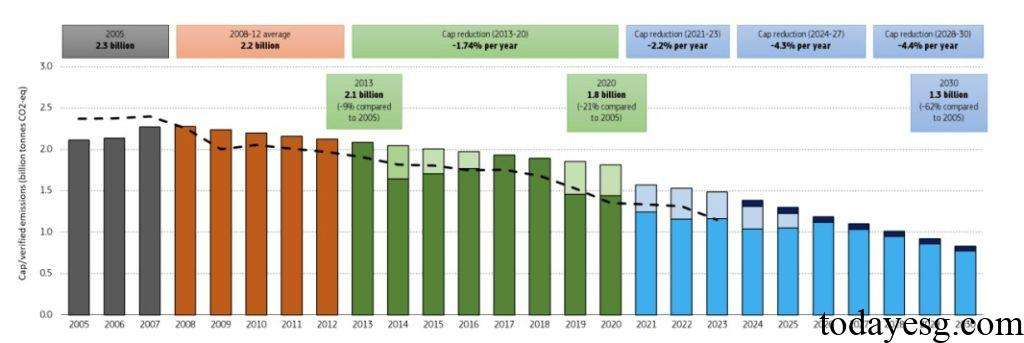2024 Climate Action Progress Report
EU releases 2024 Climate Action Progress Report, aimed at summarizing the development of EU climate actions.
The EU’s greenhouse gas emissions decreases by 8.3% compared to last year and 37% compared to 1990, indicating that EU may achieve its commitment to reduce carbon emissions by 55% by 2030.
Related Post: World Trade Organization Releases Global Climate Action Report
EU Climate Action Progress
The EU analyzes the climate action progress in 2024 from the following perspectives:
Carbon Emission
In 2023, global greenhouse gas emissions reach 53 billion tons of carbon dioxide, an increase of 1.9% compared to 2022. The EU’s greenhouse gas emissions account for 6.1% of global total emissions, compared to 14.9% in 1990. In 2023, the EU’s greenhouse gas emissions decrease by 8.3%, with the energy industry, industry, construction industry, and agricultural industry reducing emissions by 167 million tons, 41 million tons, 27 million tons, and 20 million tons, respectively. The EU’s carbon reduction achievements are closely related to energy transition, and renewable energy has become the main source of electricity production (44.7%) by 2023.

The EU Emissions Trading System accounts for 40% of the total carbon emissions in the EU. From 2005 to 2023, the EU Emissions Trading System has reduced carbon emissions by 47% and raised over 200 billion euros for carbon reduction projects. The total emissions of the EU Emissions Trading System in 2023 are 1.15 billion tons of carbon dioxide, with a total revenue of 43.6 billion euros, of which 33 billion euros are allocated to member states. The revised ETS Directive requires member countries to use these revenues for climate action and energy transition.

Land Use, Land-use Change and Forestry
The land use, land-use change and forestry sector plays an important role in climate action, with the goal of increasing EU carbon removal by an additional 42 million tons by 2030, bringing the total amount to 310 million tons of carbon dioxide. The EU requires member states to achieve no-debit by 2025, meaning that the calculated carbon emissions cannot exceed the calculated carbon removals. The EU plans to allocate a carbon removal target of 42 million tons based on the land area of member states from 2026 to 2030, and requires member states to implement additional forestry and agricultural policies.
The EU is also developing policies to protect and promote ecosystem services based on the European Green Deal. The European Union has adopted the Framework for Carbon Removals, which involves three different activities: carbon farming, carbon storage products, and permanent removals, in order to help member states achieve their carbon removal goals. The European Union has also issued the Nature Restoration Regulation to support the EU’s biodiversity strategy.
Climate Change Adaptability
The European Climate Law requires EU member states to make progress in adapting to the impacts of climate change and implement the EU Adaptation Strategy. The EU categorizes major climate risks into five types, namely food, health, ecosystem, infrastructure, and economy and finance. The EU has taken action for each type of climate risk.
Climate Investment
To achieve climate neutrality by 2050, the EU requires significant public and private investment. In October 2023, the European Union released the European Green Bond Standard, and in April 2024, the EU released the Regulation on Sustainability Ratings to establish a comprehensive framework for sustainable finance. At present, the issuance of EU green bonds accounts for 13% of the total bond issuance, and EU green financial assets account for 58% of the total asset size.

International Climate Action
The EU has collaborated with bilateral and multilateral partners to set climate goals and accelerate the transition to clean energy. The European Union has established a Task Force on Carbon Markets to encourage and support other jurisdictions to introduce carbon pricing mechanisms, ensuring the climate integrity of the international carbon market. The EU has also established green alliances with some countries to strengthen cooperation in green transition.
Reference:
Climate Report Shows the Largest Annual Drop in EU Greenhouse Gas Emissions for Decades








